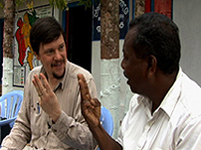

Focus Diversity and Unity
 The era of globalization elicits a fear of societal homogenization that is not entirely unjustified. The phantom of egalitarianism and the loss of identity inevitably comprise a threat to our individual, personal freedom. But when we take a closer look, we see that we are surrounded by manifold parallel worlds, plural communities, characteristic substructures and federal systems. This can be observed, not only in human cooperation on a social, political and cultural level, but also in nature: nature’s manifold powers simultaneously cooperate and compete, and yet viewed from without, they form a superordinate and self-contained entity.
The era of globalization elicits a fear of societal homogenization that is not entirely unjustified. The phantom of egalitarianism and the loss of identity inevitably comprise a threat to our individual, personal freedom. But when we take a closer look, we see that we are surrounded by manifold parallel worlds, plural communities, characteristic substructures and federal systems. This can be observed, not only in human cooperation on a social, political and cultural level, but also in nature: nature’s manifold powers simultaneously cooperate and compete, and yet viewed from without, they form a superordinate and self-contained entity.
In a remote forest in the midst of the untouched nature of northern Sweden lies the little village of Molkom. Once a year it is host to the festival “One Mind Fest”. The bittersweet documentary “Three Miles North of Molkom” portrays a “playground for adults” who wish to harmonize the forces of nature with their own. Of more than thousand international guests, seven stand in front of the camera as the protagonists of shamanist experiments. They walk on hot coals, float in cold water on a lake and test the bounds of physical exhaustion in smoke-filled sweat-tents. Complex personalities and characters submerge themselves in the esoteric, seeking freedom in nature and striving to attain inner harmony - and are confronted with other, encumbering dispositions.
The effects of diversity within politics, culture and private, family surroundings become most clearly visible in multicultural societies. Supposed unity is created or destroyed accordingly. Films from Israel are a particularly good example. Unity can be created when people approach each other or when minorities build retreats for themselves. The film “Yolki Palki” depicts the problems of the last wave of Russian immigrants to Israel, in part dead earnest, in part with a wink of the eye: although their mutual religion and the yearning for a better world unite the immigrants, this superficial unity shatters in the face of gaining a foothold in Israel, learning to speak and write Hebrew and finding a job.
 The ambivalent phenomena of sealing-off and thus of exclusion or ostracism become evident in the term “Fortress Europe”. The troubles people take on themselves to live a supposedly better life in united Europe are comparable with ancient Odysseys. Dangers, imponderabilities and illusions must be overcome. And the own fears on top. The protagonist of “Wall to Wall” travels from the no longer existing Berlin Wall to the barbed wire fences of the Spanish enclave Ceuta in Northern Africa.
The ambivalent phenomena of sealing-off and thus of exclusion or ostracism become evident in the term “Fortress Europe”. The troubles people take on themselves to live a supposedly better life in united Europe are comparable with ancient Odysseys. Dangers, imponderabilities and illusions must be overcome. And the own fears on top. The protagonist of “Wall to Wall” travels from the no longer existing Berlin Wall to the barbed wire fences of the Spanish enclave Ceuta in Northern Africa.
“It’s Hard to be Nice” tells the tale of a Bosnian taxi driver in Sarajevo, where the scars and the mentality of war are still very present today. In a world of manifold characters, obscure circumstances, relationships and mafia structures, many people resort to their families as safe havens that suggest solidarity. The film gives a bold depiction of what can happen when said solidarity falters.
 Cultural collectivisation becomes apparent by the disappearance of many languages and emerges from the political, social and ethnic dominance of colonialism to this day. “The Linguist” seeks out those languages which are threatened by extinction, whether in Siberia, USA or South America.
Cultural collectivisation becomes apparent by the disappearance of many languages and emerges from the political, social and ethnic dominance of colonialism to this day. “The Linguist” seeks out those languages which are threatened by extinction, whether in Siberia, USA or South America.
The focus of the 16th Filmfest Hamburg aims at pointing out these and other facets of identity and otherness in their diverse unity and united diversity. (Claus Friede)
Diversity and Unity: Films
Adhen
Cut Loose
Frozen River
It’s Hard to be Nice
The Linguist
Machan
Nowhere Promised Land
Pinhas
Rabbi Firer
Filmperformance ScareCity
Three Miles North of Molkom
Vasermil
Wall to Wall
Yolki Palki
